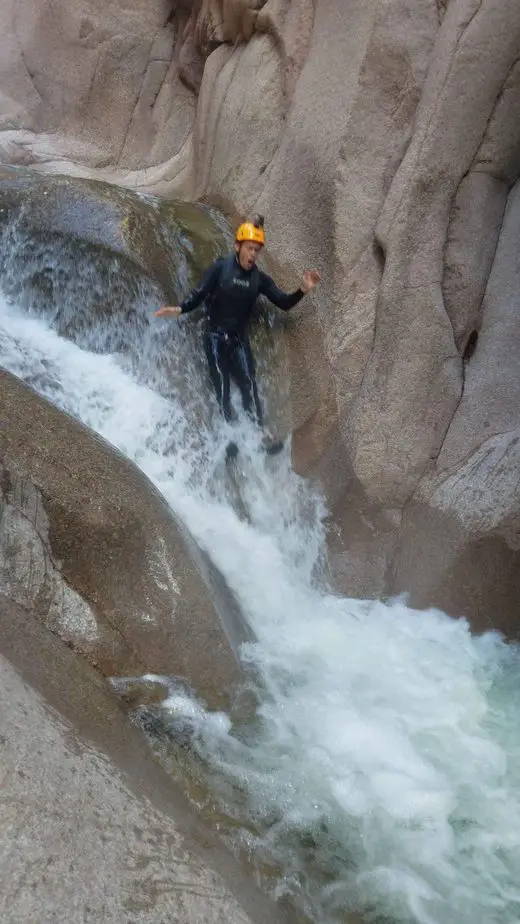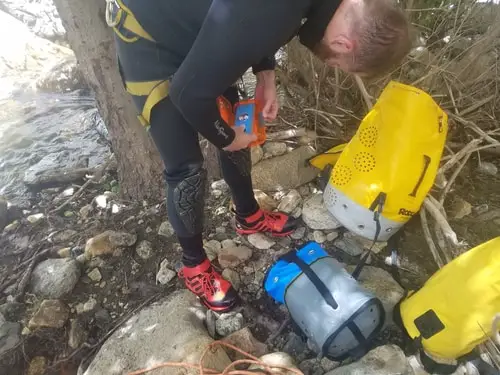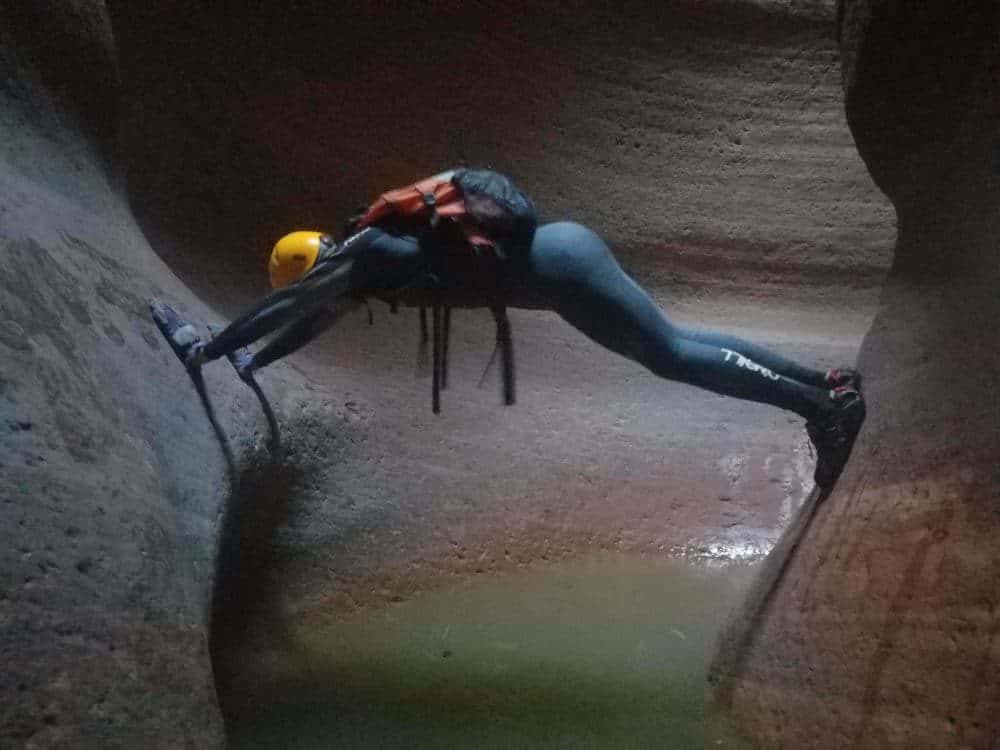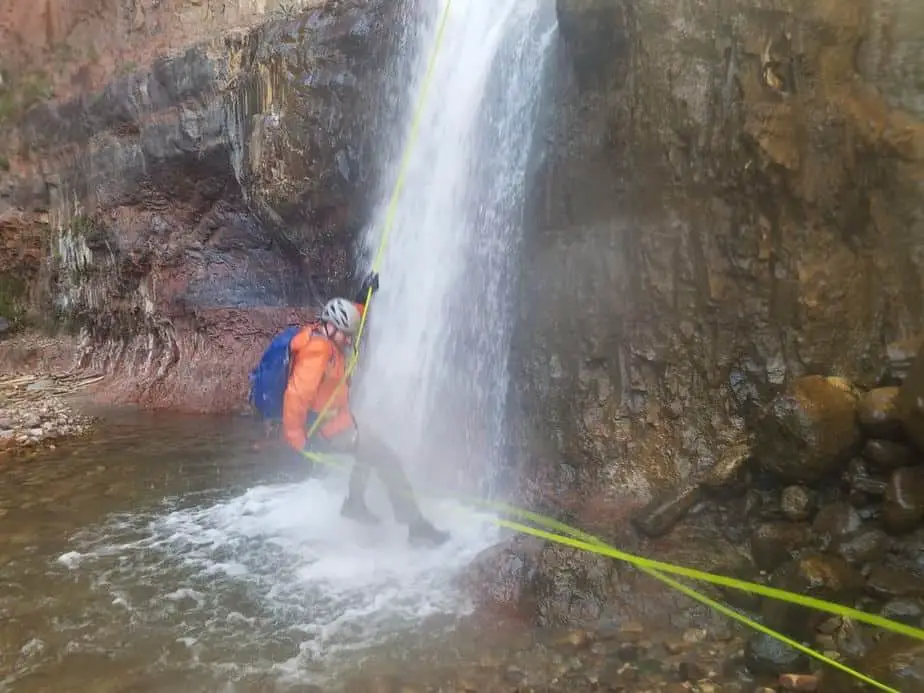Even on 105 degree days, the stagnant water in the darkest crevices of a canyon can be chilling. There’s nothing worse than hurrying through waterfall rappels and avoiding swimmers to try and stay wam- that’s why you’re in the canyon! A good wetsuit will keep you warm so you can enjoy everything the canyon has to offer.
Wetsuits designed for surfers are the best for canyoneering because they prioritize flexibility and comfort as well as warmth. For most conditions, a 4/3 full wetsuit is optimal, and can be supplemented with a shorty underneath for added warmth.
A single day in a Southern Utah canyon can wear through a wetsuit if it isn’t taken care of, so it’s important to know what you’re doing. Wetsuits aren’t designed with canyon-like conditions in mind, so the canyoneering community has come up with some great ‘hacks’ to make them last longer.
Do I Need a Wetsuit for Canyoneering?
The region you live in or go canyoning in, as well as the season of the year and type of canyon will determine if you need a wetsuit or not. Most Class A and Class B canyons are formed by snowmelt.
Snowmelt is cold! During the winter and spring, you definitely need a wetsuit for any canyon that involves water.
Even if air temperatures are pleasant, the water in potholes rarely sees sunlight and can remain really cold. You’ll be fine if you can jump in and jump out and then dry off and warm up, but if you’re in and out of puddles then you will need some help staying warm.

Wetsuits work by trapping a little bit of water inside the neoprene against your skin. Your body heat warms up the water slightly, which makes it more tolerable than the water on the outside of your suit.
Whether you need a wetsuit or not also depends on your own preferences. I hate cold water and can spend a lot of time trying to avoid it.
I usually wear one so I don’t dread jumping in or rapping down a falls. Katherine is almost always cold, and has to wear a wetsuit for just about any canyon with water.
For the majority of canyons, a 4/3mm full wetsuit is the best choice. It’s warm enough for most canyons, and you can add a shorty over the top for added warmth or to handle an especially abusive canyon. A lot of canyoneers recommend the Hyperflex 4/3 VYRL wetsuit (view price on Amazon ).
).
Types of Wetsuits for Canyoneering
Sport
There are 3 main types of wetsuits, and they each have different purposes. A diving wetsuit is designed to keep you warm in deep, cold water when you are just floating around or slightly kicking.
Because of this, it can be really hard to move your arms around. They often include hoods as well. These aren’t great for canyoning because they’re so stiff.
Triathlon wetsuits can be a good choice for canyoneering, but they’re usually not as high-quality. They’re designed for open water swimming, and usually aren’t as reinforced on the knee and elbow areas since they don’t normally wear as much.
Surfing wetsuits are the best for canyoning. They’re reinforced on the elbows and knees, are flexible enough to swim around in, and come in varying thicknesses so you can decide exactly what you want.
Length / Style
Wetsuits come in 4 main configurations. The main style, which is the most common for canyoneering, is a full length wetsuit. These wetsuits cover all the way down to your ankles and to your wrists.
A shorty wetsuit is exactly what it sounds like- it covers your torso, with short sleeves and shorts down to your knees. These are nice when you don’t want to carry a full suit through a canyon for a single swimmer or on warmer days. They also are great to wear under or over your full wetsuit to add some warmth.
The last type of wetsuit to consider is a modular approach. You can buy shorts and tops separately in whatever thickness you choose, and can double them up where you want.
Farmer John wetsuits are full wetsuits without sleeves. These can be nice if you want to add a wetsuit jacket over the top. The problem with the modular approach is that they don’t seal as well, so you may find cold spots where water gets in.

Thickness
The thickness of the wetsuit is really what affects how warm you are in the canyon. The thinnest wetsuits, starting at 2mm thick, don’t do much to keep you warm. They’re better than nothing of course, and are pretty cheap.
Most canyoneers use either a 3/2 wetsuit or a 4/3 wetsuit. The slash means that the material on your core is thicker than the material around areas that require more flexibility like your shoulders and arms.
A 3/2 wetsuit is a bit chilly in snowmelt on a sunny day, so I’d recommend the 4/3 for most canyons. It’s usually better to be too warm than too cold!
As mentioned above, you can turn a 4/3 into a warm 5/3 or warmer by adding another wetsuit over the top. It’s usually easiest to fit a shorty over or under, though I have seen some people squeeze into a bigger full wetsuit. If you go for a thinner wetsuit like a 3/2 as your go-to, consider getting a shorty a size bigger to go over the top.
Fit
Wetsuits are supposed to fit about like climbing shoes- they should be tight enough that you never forget your wearing it, but not uncomfortable. Keep in mind when you’re trying a wetsuit on that it’ll be a little bit stretchier and looser when wet.
Make sure you have a full range of motion with your arms and legs and that you can still breathe when it’s zipped up all the way! They’re usually really hard to get into when you’re dry, so it can help to dip your arms and legs in the water before sliding into a wetsuit.

Closure System
Wetsuits usually either zip up the back or around the front. You have to be pretty flexible to zip or unzip a wetsuit that zips up the back, so keep that in mind. Make sure that the zipper and velcro are in good condition, and that the seams are sewn and glued.
Quality
With wetsuits there is a lot of variability in quality, and you mostly get what you pay for. A $300 wetsuit is higher quality than a $100 wetsuit. With wetsuits, the quality comes at the seams where cheap wetsuits split more frequently. If seams aren’t watertight, you’ll notice cold water seeping all over the place.
The quality of materials also determines durability against abrasion and the warmth-to-thickness ratio. If you plan on going through particularly gritty canyons (like the sandstone canyons of Southern Utah), you may not want to splurge on a really nice wetsuit. The tips down below will help you make it last longer.
Wetsuit Accessories
There are several other ways to add on to a wetsuit. If you’re going canyoneering in particularly cold water or during the winter, you may want to wear a hood to keep your head insulated. It’s nice if you will be spending a lot of time in the spray of a waterfall, or will be jumping into pools and getting your head wet continuously.
I’ve written about it before, but neoprene booties/socks are a lifesaver. After the first encounter with water, your feet will remain wet all day. Neoprene socks really help to keep your feet from freezing. The same is true with gloves. Dive gloves can help keep your hands warm, though they aren’t as durable as something with a leather palm.
Consider wearing a windbreaker over the top of your wetsuit. It will keep the wind from causing a ‘refridgerator’ effect and cooling you when you’re out of the water by blowing through your wetsuit and evaporating water. Windbreakers make it a lot more tolerable when you’re out of the water, especially if you’re stuck in the spray of a waterfall while setting up another rappel.
Caring for a Canyoneering Wetsuit
A wetsuit only works if it remains intact. Between the stemming, chimneying, sliding, squeezing, and rappelling, your wetsuit can take quite a beating. Abrasive rocks can completely burn through your knees or elbows in a single canyon. Fortunately, there are ways of avoiding it.
Cover Up
The best way to protect a wetsuit is to wear through something else instead. Wear pants and a shirt over the top to keep it from getting shredded by the sandpaper-like rock. Clothing will help protect your whole wetsuit, and is a lot cheaper to replace than a good wetsuit.
If you’re doing a canyon with a lot of stemming or chimneying, wear elbow pads and knee pads. They’ll keep you from getting banged up and bruised as much, and will keep you from wearing holes in your wetsuit’s elbows and knees. You can see the pads we recommend in our Recommended Gear Guide.

Some gear manufacturers make harnesses that come with a detachable / replaceable seat cover to protect your harness, pants, and wetsuit. The better option, if you do a lot of sliding, is to pick up a Scuttlebutt
that come with a detachable / replaceable seat cover to protect your harness, pants, and wetsuit. The better option, if you do a lot of sliding, is to pick up a Scuttlebutt  from Imlay Gear. It can be attached to any harness, and is easily replaceable if worn through.
from Imlay Gear. It can be attached to any harness, and is easily replaceable if worn through.
Wetsuit Care
If you just stuff your wetsuit into your backpack, throw it in your car, and then stuff it in your closet at home, you will be very sad. Mold and mildew can also destroy your wetsuit, as can other nasty stuff that you pick up in potholes.
Spray it off with fresh water when you get home and then let it dry off completely before storing it. Store it hanging up if you can so that it doesn’t get creased on the folds.
If a seam bursts somewhere, you can seal it again with aquaseal and duct tape. You can extend the life of a wetsuit by lining holes with duct tape, but it’s best to prevent wear instead of trying to repair it.
Should I Use a Drysuit for Canyoneering?
Advantages to Dry Suits
- Weight- Dry suits usually weigh less than wetsuits, which makes for an easier haul. They also stuff easier than wetsuits and take less space.
- Warmth- Staying dry will always keep you warmer than being soaking wet.
- Buoyancy- A dry suit full of air will give you a little bit of flotation, which can be nice for swimmers.
Disadvantages to Dry Suits
- Durability- It can be fairly easy to tear through a dry suit, especially in canyon conditions. While a wetsuit still functions alright with a hole in it, a dry suit is worthless.
- Cost- Dry suits can cost 2 or 3 times as much as wetsuits, and you may have to replace them more often.
- Comfort- This could go either way, but there’s something comfy about wearing a wetsuit. A dry suit wraps tighter around your neck and limbs too.
If you do decide that a dry suit is for you, canyoneers seem to like the Kokotat Swift Entry model (view price on Amazon ).
).
Tips for Buying a Used Wetsuit
My personal opinion is that it’s not worth buying a wetsuit brand new. If you’re willing to buy one on Ebay or OfferUp or Craigslist instead, you can save a hundred bucks.
Wetsuits age pretty well, and are rarely worn out. Lots of people buy them for a single vacation and then put them in a box for a few years before deciding they won’t use them again (or gaining weight).
If you do decide to buy a wetsuit used you need to be aware of the sizing. You won’t be able to return it if it’s the wrong size, and you probably don’t want to try it on in someone’s garage! Look up the brand and sizing online, and read some reviews to confirm that the measurements will work for you.
Watch out for wetsuits that have a lot of wear, including pilling or any holes. Look for faded black and signs of UV damage, since this means the material is damaged and won’t be as strong or warm. Wetsuits that have been stored in boxes for a long time may have permanent creases in the neoprene- make sure there aren’t any holes along these creases.
Wetsuits for Canyoning
Wetsuits are a necessity for most wet canyons (class B & C) because water in canyons is rarely warm enough to enjoy. Canyoneering is a lot more fun when you aren’t shivering and fighting to stay warm throughout.
The first wetsuit you need is a 4/3 or a 3/2 full length. Pick up a shorty to wear under it or over the top to add some warmth for especially cold canyons or during colder seasons. Supplement your wetsuit with booties, gloves, and a windbreaker.
Take care of your wetsuit by protecting it with clothing or pads over the top, and always dry it out completely before storing it. Always be on the lookout for used wetsuits at a bargain price, because you never know when a single canyon will wear a big hole in yours!

Related Questions
Is a Wetsuit or Dry Suit better for Canyoneering? Wetsuits are more durable and cheaper than dry suits, and last a lot longer with the rigors of canyoneering. Dry suits are nice during winter months.
Do You Need a Wetsuit for Canyoneering? Deep canyons rarely see sunlight, which leaves the water very cold. Wetsuits help you stay warm so you don’t waste energy and time. They aren’t necessary in tropical places with warmer water.

